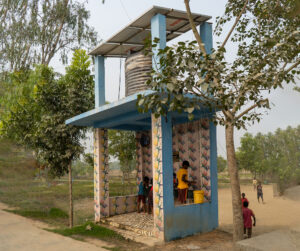Almost 5.10% of the population in West Bengal is deprived of safe drinking water (NFHS-5 Provisional Estimates (2019–20)). Access to clean drinking water is worst in coastal areas, which are exposed to frequent cyclones and tidal waves.
Frequent cyclones bring saline water from the Bay of Bengal and damage crops, vegetables, fish, and livestock, thereby increasing the salinity of agricultural land, which in turn loses its agro productivity. Not only this but during floods and cyclones, all the tube wells in the locality sink into saline water. In the past, Cyclone Amphan has created an acute drinking water crisis in both South and North 24 Parganas.
Kankandighi is one such village in Mathurapur II Block in South 24 Parganas, surrounded by rivers “Thakuran”, “Muni,” andChhatua,” and is prone to disasters like floods, cyclones, and erosion of river embankments. The drinking water bottle or pouch that gets distributed during the crisis by other organisations fails to meet the long-term water requirements of the community.

With the financial support of the German Federal Ministry for Economic Cooperation and Development (BMZ) and Caritas Germany, the Global Program mobilised people to identify their risks and collectively work to build their resilience. Palli Unnayan Samiti (PUS), one of the partner organisations of Global Programme India working in West Bengal, organised a focus group discussion with the panchayat and local community members in Mundapara in November 2021.

Lack of disaster risk reduction activities at the local level in the field of agriculture and inaccessibility to housing and safe drinking water during disasters surfaced during the meeting. Tube wells, the only source of safe drinking water, get inundated by saline water during floods, and the community faces a lot of health issues.
The global programme engaged the community to discuss, record, and plan practical solutions to the drinking water crisis. Collectively, the community has suggested panchayat members create provisions for raised tube wells or water facilities that can be accessed even during floods. A village disaster risk reduction plan was developed through a participatory approach and submitted to the panchayat in May 2022.

The construction of a water supply system with a solar pump and a reservoir was initiated by the Executive Officer of Mathurapur II Panchayat Samiti under the supervision of the local PRI. The estimated cost of the water supply system with solar pump and reservoir was approximately INR 6 lakhs for the financial year 2022–2023. This reservoir is constructed 6–7 feet above ground level with a water tank on the concrete shed and the sub-marshal motor connected by the solar panel.
Now the community has access to clean drinking water throughout the year. They come regularly to discuss and work collectively to implement the village disaster risk reduction plan and enhance resilience.


Leave a Reply